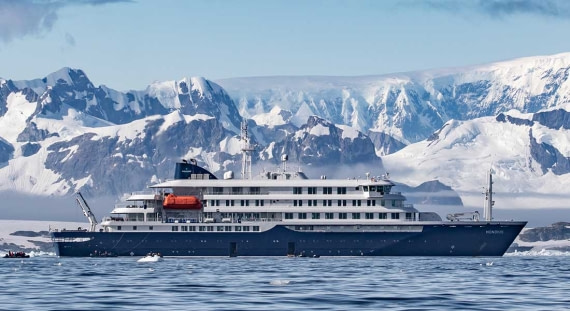| Datum: |
22.06.2024 |
| Position: |
77° 02.4' N 015° 57.5' E |
| Wind: |
E3/4 |
| Wetter: |
Teilweise bewölkt |
| Lufttemperatur: |
+3 |
Als der Morgen graute, hatte die Hondius die Nacht geschickt überstanden und uns an den südöstlichen Rand des Svalbard-Archipels, genauer gesagt in den ruhigen Hornsund-Fjord, gebracht. Die Sonne warf einen goldenen Schein auf Burgerbukta, unser erstes Tagesziel, das sich perfekt für eine morgendliche Erkundung mit den Zodiacs eignete. Die Langwanderer begannen ihre Wanderung von Morenenstranda in Richtung Tresklelodden, wo sie später am Nachmittag abgeholt wurden.
Nach dem Frühstück zogen wir eifrig unsere wärmsten Sachen an, ausgerüstet mit guter Laune und Kameras, bereit, uns auf die Abenteuer des Tages einzulassen. Die atemberaubende Aussicht auf die umliegenden Fjordberge begrüßte uns, und als wir uns dem Gletscher näherten, erwartete uns ein magischer Anblick - eine Schar von Belugas, die anmutig am Ufer entlang glitten. Unter ihnen entdeckten wir zwei graue Kälber, die sich deutlich von den cremeweißen Erwachsenen abhoben. Es war eine unbeschreibliche Freude, diese majestätischen Tiere zu beobachten und sie atmen zu hören, so dass Fotografieren überflüssig war.
Hoch oben auf den Klippen stiegen Dreizehenmöwen zu ihren Nestern auf, während uns auf dem Wasser Trottellummen, Trottellummen und sogar ein paar Papageientaucher mit ihrer Anwesenheit aus nächster Nähe verzauberten. Unsere Erkundungstour führte uns weiter zu den majestätischen Gletschern Paierlbreen und Mühlbacherbreen, die von einer beeindruckenden Landschaft umgeben sind. Ein köstliches Mittagessen, zubereitet von Küchenchef Ralf und seinem talentierten Kombüsen-Team, bot die perfekte Gelegenheit, die Wunder des Vormittags Revue passieren zu lassen.
In der Zwischenzeit setzte die Hondius die Segel zu unserem nächsten Ziel - Gnålodden, einem Lieblingsort vieler unserer Reiseleiter. Eine geteilte Anlandung und ein Vortrag von Gabi an Bord über die Geschichte des Eisbären in Bezug auf den Menschen, übersetzt von Rose, bereicherten unser Wissen und unsere Vorfreude.
Als wir uns dem Landeplatz näherten, fühlten wir uns wie in unserer eigenen Tierdokumentation. Der Begrüßungschor der Dreizehenmöwen erfüllte die Luft, als wir den Strand betraten, und ihre Rufe hallten von den Klippen über uns wider. Inmitten der felsigen Landschaft stand die Jagdhütte eines Trappers als Zeugnis der Vergangenheit. Auf den Klippen wimmelte es von Dreizehenmöwen, Trottellummen und Eissturmvögeln. Wo es Vögel gibt, gibt es auch Füchse, und wir hatten das Glück, einen Fuchs zu beobachten, der die Hänge hinaufjagte, möglicherweise auf der Suche nach seiner nächsten Mahlzeit.
Die Langwanderer erreichten nach einem ganzen Tag Trekking auch den hochgelegenen Aussichtspunkt und genossen den weiten Blick auf Gnålodden, das uns mit seiner reichen Tierwelt und dem blühenden Purpursteinbrech an den Tundrahängen verwöhnt hatte, so dass es schwer fiel, sich von diesem wunderschönen Ort zu verabschieden.
Der Abend begann mit unserer täglichen Zusammenfassung, bei der Expeditionsleiter Jerry die Pläne für den nächsten Tag erläuterte. Kaitlyn gab faszinierende Einblicke in das Leben der Belugas, und Meike erzählte eine spannende Geschichte über den Lebenszyklus der Dreizehenmöwen, die wir so zahlreich gesehen hatten.
Der Tag endete mit einem köstlichen Abendessen, das von unserem Lieblingskoch Ralf zubereitet wurde. Zufrieden und erschöpft von einem Tag voller Entdeckungen freuten wir uns auf eine erholsame Nachtruhe und waren gespannt auf die Abenteuer, die der morgige Tag bringen würde.
Lange Wanderung
Heute war der erste Tag, an dem wir unsere lange Wanderung wie geplant beenden konnten. Als wir am Morgen vom Boot aus die Landschaft betrachteten, hatten wir noch Zweifel, dass die lange Wanderung heute stattfinden würde. Die Landschaft war noch ziemlich verschneit. Aber Marco und Philipp gingen wie geplant auf Erkundungstour und wenig später waren auch wir an Land. Wir begannen unsere Wanderung mit Schneeschuhen. Wir wanderten zunächst an der Ostküste der Burgerbukta entlang und genossen einen herrlichen Blick auf den Hornsund. Das Wetter ist herrlich und sogar der 1433m hohe Berg Hornsundtind, der höchste Berg im Süden Spitzbergens, ist zu sehen. Ab und zu machten wir eine Pause, damit Marco oder Philipp den Weg auskundschaften konnten. Bei einer dieser Pausen entdeckten wir einen Buckelwal. Während der Mittagspause sahen wir sogar einige Belugawale. Die nächsten Kilometer legten wir ohne Schneeschuhe zurück, so dass wir schneller vorankamen. Unsere nächste Pause machten wir an einer alten Trapperhütte in Adriabukta. Danach stiegen wir zum Moränenkamm Treskelen auf, der weit in den Hornsund hineinreicht.
Von hier aus genossen wir eine herrliche Aussicht über die wilde Alpenlandschaft des Hornsund. Wenig später kamen wir in Tresklelodden an und wurden von den Sicherheits-Zodiacs abgeholt, die uns die ganze Zeit begleitet hatten. Wir waren so pünktlich, dass wir uns den anderen in Gnålodden anschließen konnten.






























